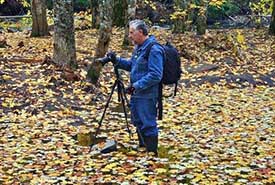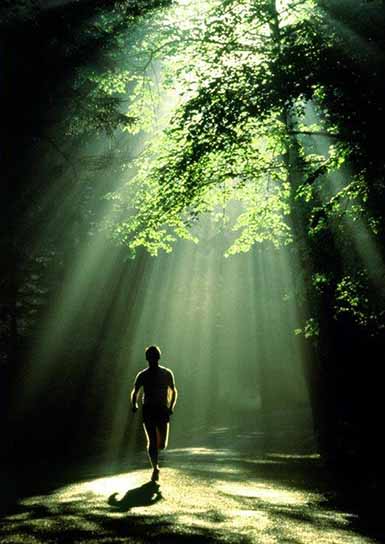
John Webb taken at Smiley’s Provincial Park 2011 (photo courtesy of Ron Kasgor)
John Webb
Nature through the lens of a camera
After a long day at his CN Rail job, John Webb was aching for a run. He grabbed his shorts and shoes and headed for his favourite haunt: Halifax’s Point Pleasant Park.
Stepping inside the forest enclave, though, his plans quickly changed.
“There was a ground fog and the rays of light were shining through the trees in a way I’d never seen before. It was stunning,” he remembers.
John ran back to his car for his camera.
The result was “The Runner,” an international award-winning photograph that has since appeared as a poster, greeting card and even a framed prize for the top finishers at a local marathon. For John, this photographic moment symbolizes his lifelong love of nature — and the ability of the camera lens to capture the beauty of the natural world and get people talking about their responsibility to protect it.

“The Runner,” by John Wm. Webb (photo courtesy of John Wm. Webb)
Since purchasing his first camera from a Windsor, Nova Scotia, five-and-dime when he was 18, the 73-year-old has, literally, snapped many thousands of pictures of natural wonders across North America, Europe, Cuba, Tibet, China, Fiji Islands, New Zealand, Galapagos Islands, Madagascar and Namibia.
The picturesque Brier Island in the Bay of Fundy is one of his personal favourites. Now retired, John travels to the remote and rugged island from his home in Ellershouse, Nova Scotia, several times a year to photograph its landscape, whales and wildflowers. While there, local botanist June Swift introduced him to the Nature Conservancy of Canada (NCC), which protects 485 hectares (1,200 acres) along the western side of the island. NCC’s Brier Island Nature Reserve provides habitat for more than 300 species of birds and several rare plants, including eastern mountain avens.
“June showed me the special places to capture the orchids, pitcher plants and eastern mountain avens,” John recalls. “She suggested that I might be able to do something to help promote the preservation of this land.”
John started making monthly donations to NCC in 1988. He has also presented slide shows of his work in support of the charity and, in 2001, he donated a collection of his Brier Island photographs to NCC.
“I try to help protect our important natural treasures by showing people images of the beauty of our natural world and explaining how important it is to protect and support our wildlife, plant life and landscapes,” he explains.
Not that the talented photographer needs to say much.
When it comes to John, NCC and Brier Island, a picture really is worth a thousand words.




